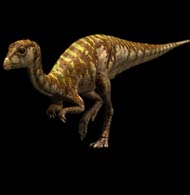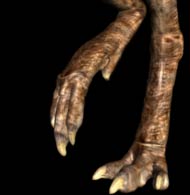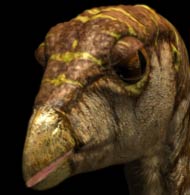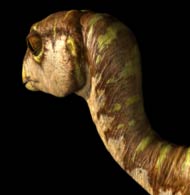
Leaellynasaura was a small turkey-sized herbivorous biped. It is one of many dinosaurs whose partial remains have been dug (and blasted) out of the solid rocks of Dinosaur Cove in the south east of Australia. In the Early Cretaceous period this part of Australia was a long way south of where it is today, attached to the vast polar continent. Although the area was forested, its climate must still have been extreme by Mesozoic standards, with no sun visible for four months of the year.
Evidence of Leaellynasaura is known from a well-preserved skull. This has unusually large eye-sockets, and two bumps further back, for the optic nerve. It has been suggested that this might indicate Leaellynasaura was adapted to the long winter darkness of the Antarctic.
If so, this implies it could withstand low, perhaps even sub-zero, temperatures. To do this, it would have needed some way of generating body heat, which some people have taken as evidence that dinosaurs were in fact warm-blooded.
Its body shape and lifestyle are based on that of its close relatives, the hypsilophodontids. These were a very successful group of dinosaurs which lived in most parts of the world.
 Leaellynasaura was a small turkey-sized herbivorous biped. It is one of many dinosaurs whose partial remains have been dug (and blasted) out of the solid rocks of Dinosaur Cove in the south east of Australia. In the Early Cretaceous period this part of Australia was a long way south of where it is today, attached to the vast polar continent. Although the area was forested, its climate must still have been extreme by Mesozoic standards, with no sun visible for four months of the year.
Leaellynasaura was a small turkey-sized herbivorous biped. It is one of many dinosaurs whose partial remains have been dug (and blasted) out of the solid rocks of Dinosaur Cove in the south east of Australia. In the Early Cretaceous period this part of Australia was a long way south of where it is today, attached to the vast polar continent. Although the area was forested, its climate must still have been extreme by Mesozoic standards, with no sun visible for four months of the year.


